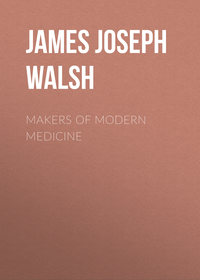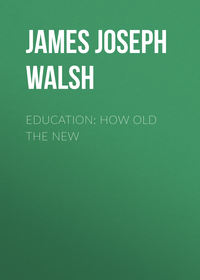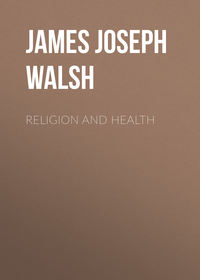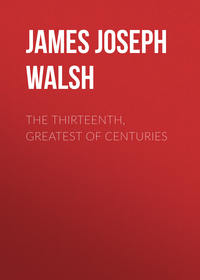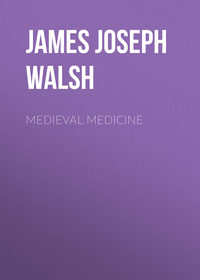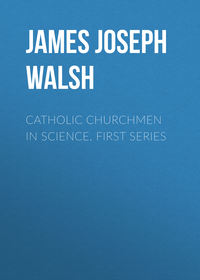 полная версия
полная версияThe Popes and Science
In the light of this simple story of Vesalius's life in Italy, and of the reasons for his going there and his departure, it is intensely amusing to read the accounts of this portion of Vesalius's life, written by those who must maintain at all costs the historical tradition that the Church was opposed to anatomy, that the Popes had forbidden dissection, and that the ecclesiastical authorities were constantly on the watch to hamper, as far as possible at least, if not absolutely to prevent, all anatomical investigation, and were even ready to put to death those who violated the ecclesiastical regulations in this matter. Dr. White, for instance, has made a great hero of Vesalius for daring to do dissection. He was only doing what hundreds of others were doing and had been doing in Italy for hundreds of years; but to confess this would be to admit that the Church was not opposed to anatomy or the practice of dissection, and so perforce Vesalius must be a hero as well as the Father of Anatomy. To read Dr. White's paragraph in the History of the Warfare of Science with Theology, one cannot but feel sure that Vesalius must practically have risked death over and over again in order to pursue his favorite practice of dissection and his original researches in anatomy. I would be the last one in the world to wish to minimize in any way Vesalius's merits. He was a genius, a great discoverer–above all an inspiration to methods of study that have been most fruitful in their results, and withal a devout Christian and firm adherent of the Roman Catholic Church. He was not a hero in the matter of dissection, however, for there was no necessity for heroism. Dissection had been practiced very assiduously before his time in all the universities of Italy, especially in Bologna, which was a Papal city from the beginning of the sixteenth century, and also in Rome at the medical college of the Roman University under the very eye of the Popes.
In the light of this knowledge read President White's paragraph with regard to Vesalius:
"From the outset Vesalius proved himself a master. In the search for real knowledge he risked the most terrible dangers, and especially the charge of sacrilege, founded upon the teachings of the Church for ages. As we have seen, even such men in the early Church as Tertullian and St. Augustine held anatomy in abhorrence, and the decretal of Pope Boniface VIII. was universally construed as forbidding all dissection, and as threatening excommunication against those practicing it. Through this sacred conventionalism Vesalius broke without fear; despite ecclesiastical censure, great opposition in his own profession and popular fury, he studied his science by the only method that could give useful results. No peril daunted him. To secure material for his investigations, he haunted gibbets and charnel-houses, braving the fires of the Inquisition and the virus of the plague." (The italics are mine.)
A very interesting commentary on the expressions of Professor White with regard to Vesalius is to be found in a paragraph of Von Töply's article on the History of Anatomy in the second volume of Puschmann's History of Medicine, already quoted. "Out of the fruitful soil so well cultivated in the two preceding centuries, there developed at the beginning of the sixteenth century the Renaissance of anatomy, with all the great and also with all the unpleasant features which belong to the important works of art of that period. One has only to think of Donatello, Mantegna, Michel Angelo, and Verochio to realize these. The Renaissance of anatomy developed in a field of human endeavor which, if it did not owe all, at least owed very much to the art-loving and culture-fostering rulers, Popes and cardinals of the time. Older historians have told the story of the rise of anatomy in such a way that it seemed that the Papal Curia had set itself ever in utter hostility to the development of anatomy. As a matter of fact, the Papal Court placed scarcely any hindrances in its path. On the contrary, the Popes encouraged anatomy in every way."
In the page and a half following this quotation Von Töply has condensed into brief form most of what the Popes did for medicine and the medical sciences, though more especially for anatomy, during the centuries from the sixteenth down to the beginning of the nineteenth. Some excerpts from this, with a running commentary, will form the best compendium of the history of the Papal relations to medical education and will show that they are strikingly different from what has usually been said. Von Töply begins with Paul III., who is known in history more especially for his issuance of the Bull founding the Jesuits. It might ordinarily be presumed by those who knew nothing of this Pope, that the Head of the Church, to whom is due an institution such as the Jesuits are supposed to be, would not be interested to the slightest degree in modern sciences, and would be one of the last ecclesiastical authorities from whom patronage of science could possibly be expected. It was he, however, who founded special departments for anatomy and botany and provided the funds for a salary for a prosector of anatomy at Rome.
After this practically every Pope in this century has some special benefaction for anatomy to his credit. Pope Paul IV. (1555-59) called Columbus to Rome and gave him every opportunity for the development of his original genius in anatomical research. Columbus had succeeded Vesalius at Padua and had been tempted from there to Pisa by the duke who wished to create in that city a university with the most prominent teachers in every department that there was in Italy, yet it was from this lucrative post that Pope Paul IV. succeeded in winning Columbus. Quite apart from what we know of Columbus's career at Rome and his successful investigation on the cadaver of many anatomical problems, perhaps the best evidence of the friendly relations of the Popes to him and to his work is to be found in the fact that, first Columbus himself, and then after his death his sons, in issuing their father's magnificent work De Re Anatomica, dedicated it to the successor of Pope Paul IV., the reigning Pope Pius IV. In the meantime Cardinal Della Rovere had brought Eustachius to Rome to succeed Columbus.
Under Sixtus V., who was Pope from 1585 to 1590, the distinguished writer on medicine, and especially on anatomy, Piccolomini, published his lectures on anatomy with a dedication to that Pope. It is well known that the relations between the professor of anatomy at the Papal Medical School and the Pope were very friendly. As was the case with regard to Colombo or Columbus, so also with Caesalpinus. Columbus was the first to describe the pulmonary circulation. Caesalpinus is generally claimed by the Italians to have made the discovery of the circulation of the blood throughout the body before Harvey. Columbus had been at Pisa and was tempted to come to Rome. Caesalpinus had also been at Pisa until Clement VIII. held out inducements that brought him to Rome. Clement is the last Pope of the century, but Von Töply mentions five Popes in the next century who were in intimate relations with distinguished investigators into medical subjects and whose names are in some way connected with some of the most noteworthy teaching and writing in medical matters during the seventeenth century.
It will be readily seen what a caricature of the life of Vesalius is Prof. White's paragraph, if one compares it with the following paragraph taken from so readily available an historical source as the article on the History of Anatomy, by Prof. Turner, of Edinburgh, in the first volume of the Encyclopaedia Britannica. The distinguished Scotch anatomist who so worthily filled the chair of anatomy at the University of Edinburgh says with regard to Berengar of Carpi, who was the professor of anatomy at Bologna thirty-five years before Vesalius's time, that, "In the annals of medicine Berengar's name will be remembered as one of the most zealous and eminent in cultivating the anatomy of the human body. It was long before the anatomists of the following age could boast of equalling him. His assiduity was indefatigable, and he declares that he dissected above one hundred human bodies." This should be enough, it seems to me, to settle the question that anatomy was permitted very freely before Vesalius's time. Professor Turner's authority in such a matter is above all suspicion. He knew the history of anatomy.
If more evidence be needed, compare with President White's fantastic sketch of Vesalius the following sketch of his great contemporary, Columbus or Colombo, to whose anatomical investigations we owe the discovery of the pulmonary circulation:
"The fame of Columbus as an anatomical teacher was exceedingly great and widespread. Students were attracted to the universities where he professed, from all quarters and in large numbers. He was an ardent student of his favorite science and was imbued with the genius and enthusiasm of an original investigator. He was not satisfied with the critical examination of mere structure, but extended his researches into the more subtle, difficult and important investigation of the physiological function. He has been most aptly styled the Claude Bernard of the sixteenth century. The work of Columbus is a masterpiece of method and purity of style, as well as on account of its richness in facts and observations. He spent over forty years in these studies and researches. He dissected an extraordinary number of human bodies. It must have been an age of remarkable tolerance for scientific investigation, for in a single year he dissected no less than fourteen bodies. He also entered the crypts and catacombs of ancient churches, where the bones of the dead had been preserved and had accumulated century after century, and there, with unwearied care, he handled and compared over a half million of human skulls."
This account was written by Dr. George Jackson Fisher in his "Historical and Bibliographical Notes" for the Annals of Anatomy and Surgery (Brooklyn, 1878-1880). All the material that Dr. Fisher used in his sketch is to be found in Roth's "Life of Vesalius," p. 256. Now, Columbus was a contemporary of Vesalius, and worked with him at Bologna. The years of their lives correspond almost exactly. When Vesalius left Padua to become the royal physician to Charles V., it was Columbus who succeeded him. Later he taught also at Pisa. Then, strange as it may seem for those who have put any faith in Dr. White's excursion into medical science, he was invited to become Professor of Anatomy at the Papal University at Rome, and it was while there that he had as many as three hundred students present at his demonstrations in anatomy and there that he did fourteen dissections in one year. The pretense that there was any ecclesiastical objection to dissection becomes absolutely farcical when one compares the life of Vesalius sketched by President White with a motive, and the life of his contemporary and successor, Columbus, by an unbiased physician, whose only idea was to bring out the facts.
According to Prof. White's opinion, Vesalius dedicated his work to Charles V. to shield himself as far as possible, and after this gave up his anatomical studies in Italy to put himself under the protection of Charles V.
Vesalius's successor, Columbus, did not have to do any such thing. Instead, he went down to Rome, and under the protection of the Popes continued to carry on his anatomical work there.
When Charles V. died, however, according to President White, a new weapon was forged against Vesalius. Vesalius was charged with dissecting a living man. President White hints that "the forces of ecclesiasticism united against the innovators of anatomy, and either from direct persecution or from indirect influences Vesalius became a wanderer." Just what that means I do not know. President White does not say that he was exiled, though that idea is implied. There is a great deal of doubt about this charge of Vesalius having made an autopsy on a living person. Roth discusses various versions. The whole thing seems to be a trumped-up story; but supposing it true, would it not be only proper that a man who made an autopsy on a living person should be brought before the court? He certainly would in our day in any civilized country. Professor Foster, of the University of Cambridge in England, following the lead of President White in this matter, blames the Inquisition for instituting the prosecution. If this were true, no more proof would be needed that the Inquisition was a civil and not a religious institution, since after all the killing of a man by a premature autopsy is a plain case of homicide.
The fact of the matter seems to be that Vesalius, who had not been very well in the unsuitable climate of Madrid, made the trip to the Holy Land, partly for reasons of health, but partly also for reasons of piety. While returning he was shipwrecked on the island of Zante and died from exposure. Vesalius had been born in Brabant, at that time one of the most faithful Catholic countries in Europe. Like most of the other great men of his time, the reformation utterly failed to tempt him from his adhesion to the Catholic Church. His greatest colleagues in anatomy and in medicine were Italians, most of whom were in intimate relations with the Catholic ecclesiastics of the time and continued this intimacy in spite of the disturbing influences that were abroad. Many of these men will be mentioned in our account of the Papal Medical School and of the Papal Physicians during the next two or three centuries. The distinguished anatomists and physicians of France in Vesalius's time were quite as faithful Catholics as he was. Even Paracelsus, the Swiss, whose thorough-going independence of mind would, it might naturally seem, have tempted him to take up with the reformed doctrines, had no sympathy with them at all. He recognized the abuses in the Church, but said that Luther and the so-called reformers were doing much more harm than good, and that until they were gotten rid of no improvement in ecclesiastical matters could be looked for. When Paracelsus came to die he left his money mainly to the Shrine of the Blessed Virgin in his native town of Einsiedeln and for masses for his soul. Since their time most of the distinguished medical scientists have been quite as faithful in their Catholicity as these two great medical colleagues of the Renaissance period. While medicine is supposed to be unorthodox in its tendencies, the really great thinkers in medicine, the men to whose names important discoveries in the science were attached, were not only faithful believers in the doctrines of Christianity, but were much more often than has been thought even devout Catholics.
At the death of Vesalius the Golden Age of the development of anatomy was not at its close, but was just beginning. Eustachius, Caesalpinus, Harvey and Malpighi were during the course of the next century to make anatomy a science in the strict sense of that word. After Vesalius's time the history of anatomy in Italy centers around the Papal Medical School to a great extent. During Vesalius's lifetime his greatest rival became the professor of anatomy there. The anatomical school of Bologna, in connection with that city, became an important focus of anatomical investigation. At this time Bologna was a Papal city. It was in the dominions of the Popes, then, as we shall see, that anatomy was carried on with the most success and with the most ardor. Far from there being any opposition to the development of the science, every encouragement was given to it, and it was the patronage of the Popes and of the higher ecclesiastics that to a great degree made possible the glorious evolution of the science during the next century.
SUPPOSED PAPAL PROHIBITION OF CHEMISTRY
A false impression, exactly corresponding to that with regard to anatomy, has been created and fostered by just the same class of writers as exploited the anatomy question, with reference to the attitude of the Popes and the Church of the Middle Ages toward the study of chemistry. This is founded on a similar misrepresentation of a Papal document. When it was pointed out that this Papal document, like Pope Boniface's bull, had no such purport as was suggested, just the same subterfuge as with regard to anatomy was indulged in. If the Papal document did not forbid chemistry directly, as was said, at least it was so misinterpreted, and chemistry failed to develop because of the supposed Papal opposition. These expressions were used, in spite of the fact that, just as in the case of anatomy, it is not hard to trace the rise and development of chemistry, or its predecessor, alchemy, during the years when it is supposed to be in abeyance. Certainly there was no interruption of the progress of chemical science at the date of the supposed Papal prohibition, nor at any other time, as a consequence of Church opposition.
The similarity of these two history lies is so striking as to indicate that they had their birth in the same desire to discredit the Popes at all cost, and to make out a case of opposition on the part of ecclesiastical authorities to scientific development, whether it actually existed or not. The surprise is, however, that the same form of invention should have been used in both cases. One might reasonably have expected that the ingenuity of writers would have enabled them to find another basis for the story on the second occasion. Still more might it have been expected that when the error with regard to the tenor of the Papal document was pointed out to them, a different form of response would be made in the latter instance. The whole subject indicates a dearth of originality that would be amusing if it were on a less serious matter, and does very little credit either to those who are responsible for the first draft of the story, but still less to those who have swallowed it so readily and given it currency.
The story of the Supposed Papal Prohibition of Chemistry was characteristically told by William J. Cruikshank, M. D., of Brooklyn, New York, in an address bearing the title, "Some Relations of the Church and Scientific Progress," published in The Medical Library and Historical Journal of Brooklyn for July, 1905. The writer called emphatic attention to the fact that chemistry, during the Middle Ages, had come under the particular ban of the ecclesiastical authorities, who effectually prevented its cultivation or development. "The chemist," Dr. Cruikshank says, "was called a miscreant, a sorcerer, and was feared because of his supposed partnership with the devil. He was denounced by Pope and priest and was persecuted to the full extent of Papal power. Pope John XXII. was especially energetic in this direction, and in the year 1317 A.D., issued a bull calling on all rulers, secular and ecclesiastical, to hunt down the miscreants who were afflicting the faithful, and he thereupon increased the power of the Inquisition in various parts of Europe for this purpose."
At the suggestion of the editor of the Medical Library and Historical Journal, I answered these assertions of Dr. Cruikshank, pointing out that the Papal document which he mentioned had no such purport as he declared, and that the history of chemistry or alchemy presented no such break as his assertions would demand. Dr. Cruikshank immediately appealed by letter to his authority on the subject, whose words, in the History of the Warfare of Theology with Science in Christendom, though I did not realize it at the time, he had repeated almost literally. In his chapter on From Magic to Chemistry and Physics, Dr. Andrew D. White says: "In 1317, Pope John XXII. issued his bull Spondent pariter, levelled at the alchemists, but really dealing a terrible blow at the beginning of chemical science. He therefore called on all rulers, secular and ecclesiastical, to hunt down the miscreants who thus afflicted the faithful, and he especially increased the power of inquisitors in various parts of Europe for this purpose." It will be seen that, as I have said, Dr. Cruikshank's words are almost a verbatim quotation from this paragraph. It is true that he has strengthened the expressions quite a little and added some trimmings of his own, still I suppose his expressions could be justified if those of President White had a foundation in fact. A little comparison of the two sets of phrases will show how a history lie grows as it passes from pen to pen. Crescit eundo--like rumor, it increases in size as it goes.
In defense of this passage in the History of the Warfare of Science with Theology in Christendom, Dr. White wrote a letter of reply to Dr. Cruikshank, which was incorporated into Dr. Cruikshank's response to my article in the Medical Library and Historical Journal. I presume that this was done with Dr. White's permission. In this letter he admitted that Pope John's decretal had no such significance as he originally claimed for it, but he still maintained his previous opinion, that this decretal, like Boniface's bull for anatomy, had actually prevented, or at least greatly hampered the study of chemistry. To this I replied with a brief story of chemistry in the fourteenth century, and though that article was published more than a year ago, no admission has been made and nothing further has been published on the subject. The material of the reply to Dr. White, to which as yet there has been no answer, is comprised in this chapter.
As I have already hinted, the most surprising thing about this citation of a Papal decree forbidding chemistry, is that it proves on investigation to be founded on just exactly the same sort of misinterpretation of a Papal document as happened with regard to anatomy. The bull of Pope Boniface VIII. forbidding the boiling of bodies and their dismemberment for burial in distant lands, did nothing to hinder the progress of anatomy, had no reference to any preparations required for dissection, and was not misinterpreted in any such sense until the nineteenth century, and then only for the purpose of discrediting the Popes and their relations to science. Pope Boniface's bull, far from being harmful in any way to education or to the people, was really beneficial, and constituted an excellent sanitary regulation which doubtless prevented, on a number of occasions, the carriage of disease from place to place.
The decree of Pope John XXII., which has been falsely claimed to forbid chemistry, was another example of Papal care for Christendom, and not at all the obscurantist document it has been so loudly proclaimed. Pope John learned how much imposition was being practiced on the people by certain so-called alchemists who claimed to be able to make silver and gold out of baser metals. In order to prevent this, within a year after his elevation to the pontificate he issued not a bull, but a very different form of document–a decretal–forbidding any "alchemies" of this kind. The punishment to be inflicted, however, instead of being the penalty of death, as Dr. Cruikshank, Dr. White and many others have declared, or at least let it be understood from their mode of expression, was that the person convicted of pretending to make gold and silver and selling it to other people, should pay into the public treasury an amount equal to the supposed amount of gold and silver that he had made. The money thus paid into the public treasury was to be given to the poor.
The best way to show exactly what Pope John intended by his decree is to quote the decree. It does not occur in the ordinary collection of the bulls of John XXII., for it was not, as we have said, a bull in the canonical sense of the term, but a Papal document of minor importance. There is an important distinction between a decree and a bull, the former being but of lesser significance, usually referring only to passing matters of discipline. The decretal may be found in the Corpus Juris Canonica, Tome II., which was published at Lyons in 1779. It is among the decrees or constitutions known as Extravagantes. [Footnote 14]
[Footnote 14: The meaning of this term we discussed in the previous chapter on Anatomy in relation to the bull of Boniface and Liber VI. The motto of the publisher of the volume in which it occurs deserves quotation because of its apt application in the present circumstance. It is in Latin: "Quod tibi fieri non vis, alteri ne feceris"–"What you would not have done to yourself, don't do to another." If writers about the Popes were as careful to substantiate accusations against them as fully as they would like any accusations against themselves to be corroborated before being accepted and circulated, we should hear much less of Papal intolerance and of Church opposition to science. Even a dead Pope must be considered as a man whose reputation one should not malign without good reason and substantial proof. I must add that, as with regard to the other Papal documents mentioned, I owe the copy of this decree to Father Corbett, of St. Charles Borromeo Seminary, Overbrook, Pennsylvania, and am indebted to him besides for many helpful suggestions.]





